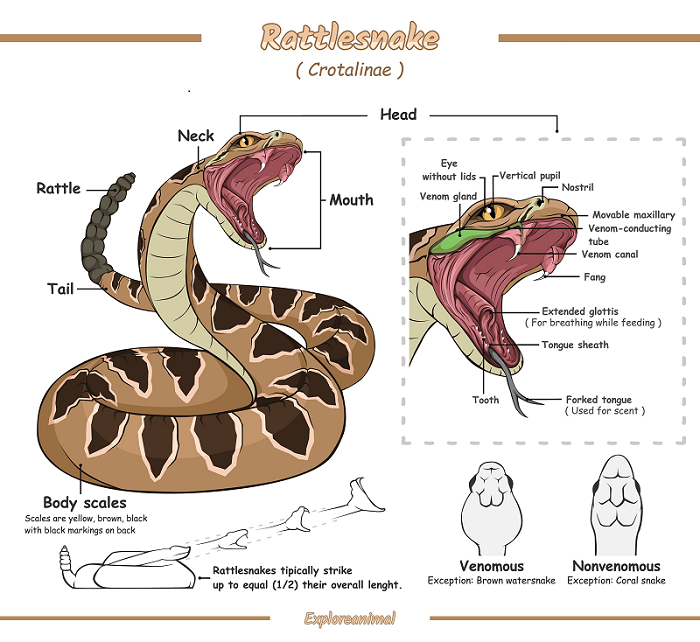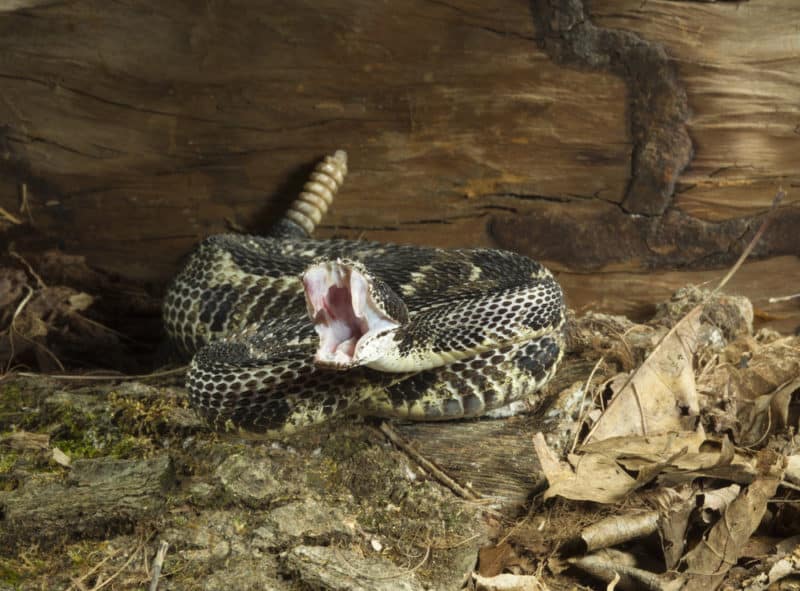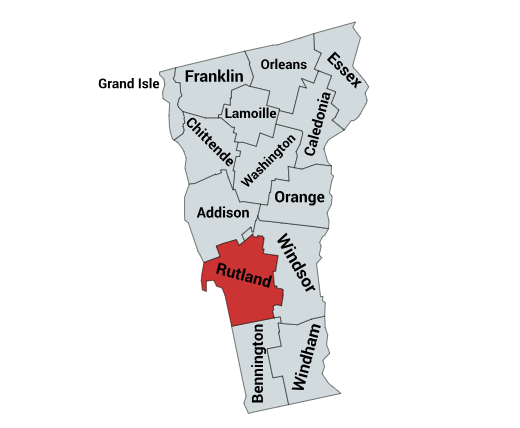There are eleven different snakes in the state of Vermont. The only venomous snake species is the Timber Rattlesnake. (Crotalus horridus)
Timber Rattlesnakes are an endangered species in Vermont. Loss of habitat and human persecution are their biggest challenges.
Timber Rattlesnakes play an important ecological role in their environment. They help keep rodent populations in check. They also control the number of disease-spreading ticks. We will talk more about that later.
The paragraphs below will tell you about Vermont’s Timber Rattlesnakes. First, though, we’ve got a section on pit vipers and another on rattlesnakes in general. The reason for this is that rattlesnakes are pit vipers. Learning about pit vipers enables us to understand Timber Rattlesnakes more fully.
Pit Vipers
Pit Vipers in the United States are Rattlesnakes, Copperheads, and Cottonmouths. They all belong to the venomous Crotalinae or pit viper family. Pit vipers have a facial pit between their nostril and eyes on each side of their face. These pits are specialized organs that detect body heat from warm-blooded prey. Pit organs enable pit vipers to strike their prey precisely, even in the dark. They are also able to detect body heat from about 1 meter away. See
These snakes also have a triangular head attached to a slender neck. Furthermore, the pupils of their eyes are vertical slits.
Pit vipers have hollow fangs connected to venom glands on each side of the roofs of their mouths. They use their fangs to inject venom into their prey. This venom immobilizes the prey, making it easier for the snake to consume. All pit vipers are born with multiple fangs and replace them every couple of months. Old fangs are shed one at a time. Consequently, a pit viper bite may only involve one fang.
Interestingly, these snakes have a sphincter on each venom gland. This allows them to control the amount of venom going through the fangs. A snake may elect not to inject any venom with a bite. Scientists surmise that this is because it takes time to rebuild its venom store. Twenty to twenty-five percent of pit viper-to-human bites are dry bites. In other words, they are venomless. Source
Pit viper food sources include small mammals, reptiles, amphibians, small birds, and insects. These snakes play an important role in maintaining balance in rodent populations.

Rattlesnakes
The first thing people think about with regard to rattlesnakes is their tails. When they are disturbed, they vibrate their rattles using their tail muscles. This makes a buzzing or rattling-type sound. The specific purpose of the rattle is to warn larger animals to stay away. Sometimes, rattlers strike without rattling, though. Sometimes, their rattles fall off.
You must be aware of where you place your hands and feet in rattlesnake country. If you hear a rattling sound, do not move until you spot where it’s coming from. Otherwise, you may accidentally move into the snake, provoking it to strike you. You should carefully move to a safe distance when you’ve located the snake. But carefully scan your surroundings because the snake you see might not be the only one around.
When moving through a known rattlesnake area, you should have your dog on a leash. If you have hunting dogs, they should be wearing snake armor.
It’s a good idea to carry a long stick. You can use it to tap the ground in front of you to warn any snakes of your approach. You can also use the stick to part any dense vegetation or tall grass in your path.
If you are hiking in rattlesnake country, it would be a good idea to wear snake boots or snake gaiters. This protects your lower legs from being bitten by a snake.

Timber Rattlesnakes in Vermont
Timber Rattler and Canebrake Rattlesnake are both common names for the Timber Rattlesnake. Generally, in higher-elevation habitats, they are called Timber Rattlesnakes. On the coastal plain, though, they’re called Canebrake Rattlesnakes.
Habitat loss and human persecution are scourges for Vermont’s rattlesnake population. Bounty hunting for timber Rattlesnakes was discontinued in Vermont in 1971. In 1987, they were listed as an endangered species in the state.
Ophidiomyces ophiodiicola is a skin fungus that affects snakes and other reptiles. Its effects are often fatal. A common name for this fungus is snake fungal disease (SDF). In 2012, Ophidiomyces ophiodiicola was detected in Vermont’s Timber rattlesnakes. SDF may further complicate the recovery of these snakes in the Green Mountain State.
Timber rattlesnakes are very rare in Vermont. They are a species of great conservation need (high priority) in the state’s Wildlife Action Plan. Record any sightings of this species with a picture. After that, contact the Vermont Fish & Wildlife Department.
What Do Timber Rattlesnakes Look Like?
| Scientific Name: | Crotalus horridus |
| Description: | Adult Timber Rattlesnakes grow between 36 and 60 inches (.91 to 1.52m) long. Their bodies are yellowish-brown with a dark chevron pattern. They also have a rusty stripe down their backs. Their tails are dark brown or black. |
| Habitat: | Timber Rattlesnakes prefer wooded areas and hillsides with rocky outcroppings. |
| Conservation status: | They are endangered in Vermont. |
The Timber Rattlesnake is a thick snake. On average, they grow between 36 and 60 inches (.91 to 1.52m) long. However, there have been reports of them growing up to 7 feet (2.13m) long.
These snakes vary in color; some have a gray, pinkish hue body. They have a stripe down their back that ranges from pinkish, orange, brown, or black. They also have dark brown to black W-shaped cross bands on their back and sides. Some of the snakes are very dark and almost entirely black. At the end of the tail, they have a yellowish-brown rattle.
Timber rattlesnakes live up to 30 years in the wild, which is a long time for a snake.
Rattlesnake Imitators in Vermont
Vermont’s snakes include some rattlesnake imitators. These include the eastern milksnake, the northern watersnake, and the eastern hog-nosed snake. The eastern milk snake and the northern watersnake are marked similarly to rattlesnakes. Eastern hog-nosed snakes are variable in their coloration. In some of their morphs, though, they look a lot like rattlesnakes. Each of these non-venomous snakes mimics rattlesnakes by vibrating their tails. If their tail is vibrating in dry leaves, the effect can be quite convincing.
Where Do Timber Rattlesnakes Live?
Timber Rattlesnakes range throughout the central and eastern United States. The western extent of their range is Minnesota in the North and Texas in the South.
Eastern Timber Rattlesnakes are declining in numbers mainly due to habitat loss. In New England, they are extirpated from Maine and Rhode Island. They are endangered in Connecticut, Massachusetts, Vermont, and New Hampshire. They’re also endangered in New York, Massachusetts, New Jersey, Virginia, Indiana, Ohio, and Illinois.
The Timber Rattlesnake lives in various habitats. They favor rugged terrain. This includes forested areas, rocky hillsides, swamps, agricultural areas, and river floodplains. These snakes are marvelous climbers and have been found in trees at heights of more than 80 feet. Source

Where Do Timber Rattlesnakes Live in Vermont?
There are only two populations of Timber Rattlesnakes in Vermont. Both of these are in western Rutland County. The areas where both of these populations den are owned by the Nature Conservancy. Source
Wintertime Brumation
Snakes and other reptiles brumate in the winter. Brumation is a reptile’s version of hibernation. Vermont has long cold winters. Consequently, Timber Rattlesnakes there spend over seven months of the year in brumation.
Timber Rattlesnakes make wintertime dens in sheltered spots. A den site could be underneath rock slides and logs, as well as in rock crevices. Individual rattlesnakes might brumate alone in some parts of their range. But in other areas, they congregate in dens with other snakes through the winter.
Den sites are usually placed on south-facing hillsides. This is because they get more warmth from the sun. They don’t always share their dens only with Timber Rattlers. Sometimes, they share their dens with other species of snakes. In Vermont, you might find an eastern Ratsnake denning with Timber rattlers. These wintertime dens may hold up to 60 snakes.
Male and non-pregnant female snakes leave their winter dens behind each spring. They range out up to 4 miles. They usually return to the same den each fall, though.
On the other hand, gravid females remain close to their winter dens.
What Do Timber Rattlesnakes Eat?
Timber rattlers prey on small mammals. These include mice, rats, squirrels, eastern chipmunks, and bats. They also eat small birds, other reptiles, and amphibians.
The experts have proven that timber rattlesnakes help control Lyme disease. This is because as they consume rodents, they’re also consuming ticks. A Timber rattler will consume 2,500 to 4,500 ticks per year, depending on the location. See
What Eats Timber Rattlesnakes?
There are several potential predators of Timber Rattlesnakes in Vermont. These include Eastern Milksnakes, Northern Black Racers, birds of prey, skunks, and bobcats.
How Dangerous Are Timber Rattlesnakes?
Timber Rattlesnakes are among the most dangerous snakes in North America. This is due to their long fangs and high venom yield. 1% to 10% of the time, an untreated Timber Rattlesnake bite results in a fatality.
Fortunately, these snakes have a relatively mild disposition. They generally give ample warning before actually striking defensively. Also, 40% to 60% of the time, they produce dry bites. In other words, although their fangs penetrate the body, they do not inject any venom. Source
These snakes produce hemotoxic venom. Timber Rattlesnake bites sometimes cause serious complications. These include shock, seizures, coma, internal bleeding, and deep tissue damage. Source
Timber Rattlesnake Conservation in Vermont
Starting in 2011, Vermont Fish and wildlife biologist Doug Blodgett led a two-year project. It was to study endangered timber rattlesnakes in western Rutland County. The Nature Conservancy and Orianne Society were project partners.
The study aims are the following.
- Map critical habitats.
- Gain insights on population dynamics/ genetics.
- Provide outreach and education to foster tolerance/acceptance for the species.
In the study, 144 individual Timber Rattlesnakes were captured. This was at the state’s largest denning site. These snakes were examined for overall health and implanted with radiotelemetry chips. One of these chips is called a Passive Integrated Transponder. The acronym for this is PIT tag. The snakes’ DNA was also collected.
The movements of PIT-tagged snakes were tracked over the two years.
The study’s findings provide insights into rattlesnake travel corridors and home ranges.
In 2019, Doug Blodgett retired from the Vermont Fish and Wildlife Department. The new head Vermont reptile and amphibian biologist is Luke Groff.
In his position, Groff is in charge of monitoring Vermont’s endangered snake species. These include the eastern rat snake, the northern racer, and the Timber Rattler. Source
Here is some time-lapse video footage taken from a trail cam that Groff set up at a den site. This, of course, is in Rutland County, Vermont.
Symptoms of Venomous Snake Bites
Some of the symptoms you may experience when a venomous snake bites you include:
- Discoloration in the area of the bite.
- Swelling in the area of the bite.
- Loss of muscle coordination.
- Tingling sensation in the area of the bite.
- Feeling nauseous.
- Having a faster heartbeat or rapid pulse.
What Should You Do if You Are Bitten?
If you or someone you are with has suffered a venomous snakebite, time is of the essence. Because the sooner a victim receives antivenom, the less chance the venom in their body has to cause harm. In other words, it is important to seek immediate medical treatment.
Do not attempt to kill the snake for identification purposes. This gives the snake a chance to bite you again. Also, consider that severed snakeheads can still bite and envenomate and often do. If you have a phone, take a photo of the snake. Otherwise, get started on your way to the nearest hospital.
First Aid for Snake Bite Victims
- Remain calm and limit your movements. Do not run. If you must hike back to a vehicle, do it calmly and deliberately. Put as little stress on your heart as possible.
- Keep the area of the snake bite below the heart level and never above the heart level. Keeping the bite below the heart level will reduce the venom’s flow. However, holding the bite above your heart level will increase the venom’s flow.
- Remove all constricting items such as bracelets, watches, or rings before swelling occurs.
- Remember that using a cold compress on a venomous snake bite is not advisable. The cold may cause the local blood vessels to constrict and spread the venom faster.
- You can wash the affected area like any other wound with soap and water.
- You may cover the bite area with a moist dressing to reduce the swelling.
- Get medical attention as soon as possible. Call the hospital to tell them a venomous snake has bitten you. So they can have antivenom ready to give you when you arrive.
- A person whom a venomous snake has bitten may go into shock. If this happens, lay them flat and cover them with a blanket.
Dressing for Snake Country
- High-top leather boots and long pants are both wise ideas.
- Also, wear loose-fitting denim. If there’s a gap before the snake’s fangs touch your skin, your chances of being envenomated are lower.
- In the absence of high-top leather boots, some people wear snake gaiters.
Recent Posts
The only venomous snakes in Washington State are Northern Pacific Rattlesnakes. The Northern Pacific Rattlesnake (Crotalus oreganus oreganus) is a sub-species of the Western Rattlesnake. Anyone...
Skunks are not classified as true hibernators. But they go into a state of torpor when the weather gets cold. Skunks are light sleep hibernators, along with opossums, bears, and raccoons. ...

